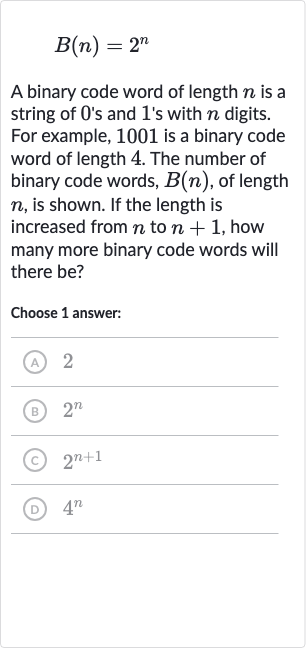AI tutor
Welcome to Bytelearn!
Let’s check out your problem:

A binary code word of length is a string of 's and 's with digits. For example, is a binary code word of length . The number of binary code words, , of length , is shown. If the length is increased from to , how many more binary code words will there be?Choose answer:(A) (B) (C) (D)
Full solution
Q. A binary code word of length is a string of 's and 's with digits. For example, is a binary code word of length . The number of binary code words, , of length , is shown. If the length is increased from to , how many more binary code words will there be?Choose answer:(A) (B) (C) (D)
- Problem Understanding: Understand the problem.We are given a function , which represents the number of binary code words of length . We need to find out how many additional binary code words are possible when the length increases from to .
- Calculate Binary Code Words of Length : Calculate the number of binary code words of length . Using the given function, the number of binary code words of length is .
- Calculate Binary Code Words of Length : Calculate the number of binary code words of length . Using the same function, the number of binary code words of length is .
- Determine Increase in Binary Code Words: Determine the increase in the number of binary code words.To find out how many more binary code words there are when the length increases from to , we subtract the number of binary code words of length from the number of binary code words of length .So, the increase is .
- Simplify Expression for Increase: Simplify the expression for the increase.We can factor out from the expression to simplify it:.
- Choose Correct Answer: Choose the correct answer.The increase in the number of binary code words when the length increases from to is . This corresponds to answer choice (B) .
More problems from Compare linear and exponential growth
QuestionGet tutor help
QuestionGet tutor help
QuestionGet tutor help
QuestionGet tutor help
QuestionGet tutor help
QuestionGet tutor help
QuestionGet tutor help
